Crystal Palace Building in London – Explore the Historic Site
The Crystal Palace Building in London was one of the most influential pieces of pre-Modern architecture to have ever been designed. Its glass and iron design would go on to influence the development of many structures long after the Crystal Palace stopped existing. This article will examine the Crystal Palace’s architecture, history, impact, reconstruction efforts, and its present existence. Keep reading to learn more about the Crystal Palace Building in London!
A Look at the Crystal Palace Building in London
| Architect | Joseph Paxton (1803 – 1865) |
| Date Constructed | 1850 – 1851 |
| Function | Exhibition venue |
| Materials Used | Cast iron and plate glass |
| Cost | £80,000 (£12 million in 2022) |
| Location | London, United Kingdom |
The Crystal Palace Building in London is one of the most important structures in terms of Modernism to have ever been constructed. The building itself was not actually Modernist at all, as Modernism did not yet exist as a philosophy, and architecture in that vein did not truly exist until the early 20th century, but the Crystal Palace Building in London would have a profound influence on Modern architecture in subsequent decades.
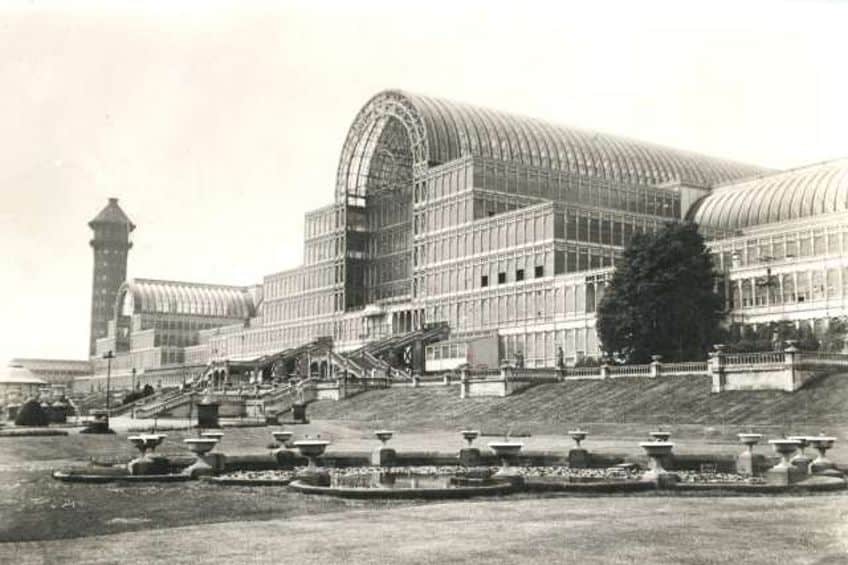
Essentially, the Crystal Palace’s architecture was way ahead of its time and was designed around principles the likes of which had yet to be seen in any structures up until that point in time. The Crystal Palace Building in London is not only notable as a structure but as a venue too. It was the site of the first Great Exhibition of 1851, and so the structure was not only an important piece of architecture in and of itself, but it was also an important structure because of what was housed within its walls.
The items within it may have decreased in their importance following the conclusion of the Great Exhibition, but the building continued to be used long after its technical origins had run their course.
The History of the Crystal Palace Building
The Crystal Palace Building in London, in basic terms, was a massive structure made of iron, glass, and wood that appeared like a gigantic greenhouse. It was far ahead of its time in terms of its sheer scale and general design. It was a truly gorgeous structure too. However, its purpose was also historically significant. So, why was the Crystal Palace Building in London built in the first place?

The Great Exhibition of 1851
While the plans for the Great Exhibition of 1851, also known as the Great Exhibition of the Works of Industry of All Nations, were underway, it was decided that the actual exhibition needed to have some kind of a place to be hosted. This was what the Crystal Palace Building in London was designed for in the first place. However, what exactly is the Great Exhibition and why was it such a significant thing in the first place?
The basic answer to this question is rather simple, but there will be additional elaboration on the specific technological items that were on display within the exhibition later in this article. For now, let’s explain how the Crystal Palace’s history is intrinsically tied in with the exhibition. The primary aim of the Great Exhibition of 1851 was to start a global conversation about technology and to start a trend towards exhibiting new and innovative technology from around the world.
It was essentially the first of the World’s Fairs that would become so important throughout the 19th century.
The basic premise of these World’s Fairs was to create an internationalist sense of cohesion in which inventors, scientists, and engineers from around the world could gather together in one place to show the people of the world what they had created. In terms of the first one, it was located in Hyde Park, London, and was organized by a combination of Henry Cole, who was a British inventor, and Prince Albert, the husband of Queen Victoria.
This first Great Exhibition attracted many inventors from around the world, and during the several-month course of the event, which ran from 1 May to 15 October of that year, it proved to be a massive success. People from all over the world attended, and many local British citizens were able to see some of the latest in technology up close and personal. These World’s Fairs were periods of immense excitement about what the future could hold for human technological development. Interestingly, for those who are interested, World’s Fairs actually still take place every few years, they simply aren’t as famous as they once were.

The Original Crystal Palace in Hyde Park
The significance of the Great Exhibition of 1851 in London is not easy to overstate. It was an immensely important event that changed the course of technological history around the world by fostering an air of internationalism and collaboration. However, what about the Crystal Palace itself? Why was it the perfect site for such an important piece of human history? Why was the Crystal Palace’s architecture so ahead of its time?
The specifics of the Crystal Palace in London’s actual design will be discussed in a later section, but the importance of the structure is easy to understand without the exact specifics. It was unlike anything that had ever been seen before. It must be understood that before the development of the Crystal Palace, nothing of this kind had ever existed.
Before this, buildings were made of brick and mortar. They were built with heavy walls and windows were the exception rather than the rule. The Crystal Palace in London changed that.
Instead of building something that simply had a lot of windows, they designed the walls themselves to be windows. It was a precursor to the kinds of steel frame glass structures that would dominate cities in constructions such as skyscrapers. However, the Crystal Palace in London predates skyscrapers by several decades, and while steel did exist at the time of this building’s construction, it was not yet being used to develop the kinds of steel frames that are still used to this day. So, while the Crystal Palace does use an iron frame, it was still something far ahead of its time.
The Great Exhibition within the glass walls of the Crystal Palace may have been important for global technology and international cooperation, but the structure in which it was presented was also a magnificent sight. It was also, fascinatingly, designed to be a temporary structure. It was never meant to exist beyond the needs of the Great Exhibition, but it was such a massive hit that it couldn’t have been torn down. Could it?

The Relocation to Sydenham Hill
The Great Exhibition came to an end as all events of its kind must eventually come to an end, but the Crystal Palace in London was never intended to remain there. However, thanks to its immense popularity, it was ultimately decided that the Crystal Palace needed to be moved. It should not be destroyed, because that would have caused an outcry (and it was simply an impressive structure that deserved to continue its existence), so deliberations began.
The ultimate decision was to move the Crystal Palace to another location within London called Penge Place.
In more specific terms, it was reconstructed, after being carefully disassembled, between 1852 and 1854 at the top of Penge Peak. This location was right beside an affluent London neighborhood called Sydenham Hill. This would be the home of the Crystal Palace in London until 1936. Once the Crystal Palace in London had been reconstructed in its new location, various aspects needed to be redesigned for longevity. There was a new façade designed for the entrance, new staircases, and even terraces. The original structure had been intended to remain standing for a few months, but this new version was set to last a lot longer. However, it would not last forever. So, what happened to the Crystal Palace then? Why does it no longer exist?
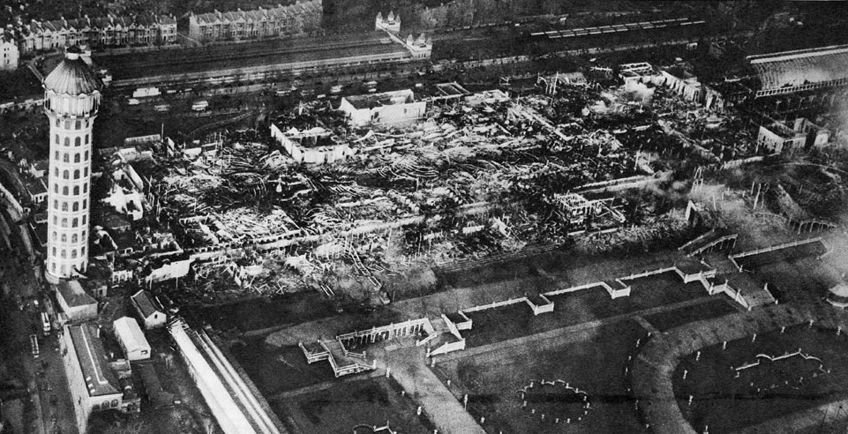
The Destruction of the Crystal Palace
The Crystal Palace’s architecture was meant to last for a short time, but it managed to last quite a lengthy period. After its relocation, it remained popular for several decades but as time went on, all things eventually became common sights and it was no longer as popular as it once was. It fell further and further into disrepair as time went on and the maintenance costs were substantial. That all came to an end one evening. The evening of 30 November 1936.
Everything was seemingly normal when a passerby noticed something inside the building, a glow. Upon entering, there appeared to be a small fire that had started. There were two employees who were attempting to extinguish it. They soon realized that the fire was spreading and called the fire department.
Over the next few hours, over 400 firefighters arrived alongside 89 fire engines, but the fire continued to expand and grow.
Unlike a building made of brick and mortar, the Crystal Palace’s glass design could not withstand it, and the fact that the flooring was also made of decades-old wood meant that there was more than enough kindling to see the entire structure go up in flames. This was exactly what happened, and people from around the area came to see the blaze. The Crystal Palace in London saw some of its highest attendance while it burned. Over one hundred thousand people arrived to watch the famous piece of pre-Modern architecture burn, and within a few hours, the building was gone. So, that is what happened to the Crystal Palace.
The Design and Architecture of the Crystal Palace Building
The Crystal Palace in London may not have lasted forever, but who designed the Crystal Palace in the first place? What were some of the specifics of its construction? Let’s have a look at some of these questions to see what made this particular piece of pre-Modern architecture such an important piece of architectural artistry.

The Vision of Joseph Paxton
Who designed the Crystal Palace in the first place? The man behind the design was Joseph Paxton. Interestingly, Paxton was not actually known as an architect, but rather as a garden designer. Prior to his involvement, there had been a lot of difficulty in finding someone to design it, and there were many people who attempted to submit plans. It was ultimately Paxton’s unique ideas that had become the most innovative of the lot.
Joseph Paxton’s work led him to the development of many greenhouses.
He had worked in both private and public gardens, and over the course of his career, he had developed and experimented with different types of glass-based greenhouses. One of the things he had done was to create a modular design that could allow for new sections to be easily added without the need for massive changes to be made to the overarching structure. Basically, his greenhouses could, theoretically, be expanded indefinitely without causing any kind of structural instability.
He designed a unique glasshouse construction that was also significantly cheaper to produce than a building made in a more traditional brick-and-mortar fashion. So, his design was chosen, and construction was soon underway to produce a new and innovative kind of building, the likes of which had never been seen before.

The Construction of the Building
Joseph Paxton’s plans were chosen, and construction was soon underway. The building would start construction in 1850 and only a year later, it was completed. The other impressive aspect of the design of the Crystal Palace in London was that it could be designed and constructed in less than a year, and it stayed both within budget and schedule. This is the kind of clean and smooth construction that hardly ever occurs, and the use of the modular design in which more modules can be easily added meant that the structure could be expanded if need be (and it also aided in its ability to be later taken apart and moved to an entirely different part of London).
In the end, the Crystal Palace in London was a long structure at 564 m (or 1,851 ft) and it stood at 39 m (or 128 ft).
So, while the height is not particularly large by today’s standards, by the standards of the mid-19th century, this structure was huge. An interesting size comparison that can be made with regard to the Crystal Palace Building in London is that it was actually three times the size of the famous St. Paul’s Cathedral in London. This glass and iron structure was not a trifling matter.
The Use of Iron and Glass
The Crystal Palace in London is noted for its use of both iron and glass in its construction. Upon completion, the full scope of the design became clear as it was constructed out of 60,000 panes of glass. This glass could then be set into the iron frame that surrounded the structure, and these iron frames could be indefinitely replicated to continuously expand on the general size of the construction as a whole. One of the most interesting aspects of this particular design was also that this modular design was so sturdy in its general construction that these modules could be constructed on top of one another. This meant that the Crystal Palace in London could have multiple floors even though it was essentially a massively elaborate greenhouse.

However, one of the major issues that faced the structure was rain. The building was designed to allow water to filter out and away from it, but the structure actually had leaks all over the place. These leaks were plugged up, but this does show that the construction was not quite as sophisticated as the kind of glass and steel constructions that can be designed and implemented today.
The Crystal Palace’s Influence on Architecture
In subsequent decades, the Crystal Palace in London became an architectural marvel, and it would have an influence on groups such as the Modernists. Joseph Paxton, the designer of the structure, would even go on to receive a knighthood for his work, and structures of this variety now became a possibility in the world.
The Crystal Palace’s influence, which will be discussed in more detail later in this article, cannot be overstated.
The Significance of the Crystal Palace Building
The Crystal Palace Building in London was a wildly successful structure when it was created. It was adored by the public, it was influential on subsequent architects and designers, and it housed one of the most historically important technological events in the history of the modern world. So, why was the Crystal Palace so significant in the first place?
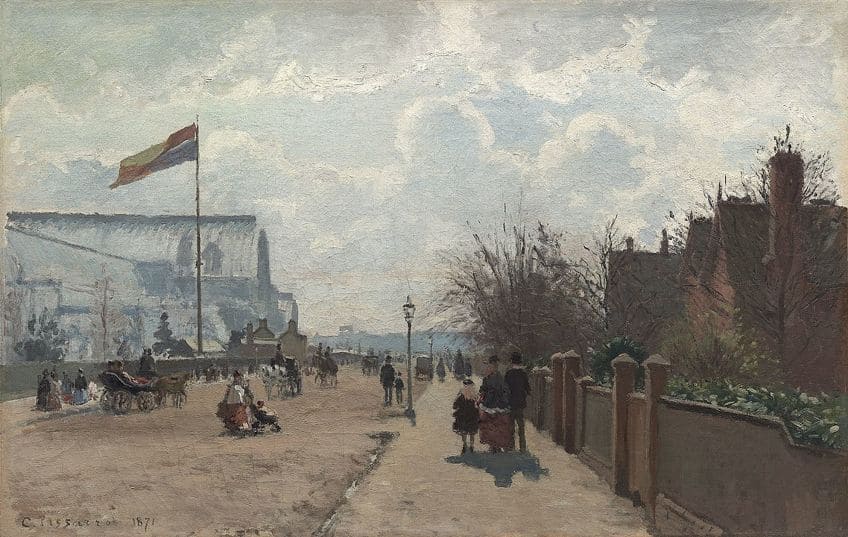
The Impact of the Great Exhibition
Possibly the most important thing that the Crystal Palace Building in London did was house the Great Exhibition of 1851. This exhibition, as has been mentioned, was an immensely influential event that changed the course of technological history by fostering a sense of international collaboration. However, that is the establishment of a trend.
What about the actual exhibition itself? What was at the Great Exhibition of 1851?
The Crystal Palace’s Role in Showcasing Innovation and Technology
The Crystal Palace may have been a magnificent structure that had a major influence on world architecture, but the Great Exhibition within its glass walls was also significant. There were about 14,000 different exhibitors who were showing off their inventions and wares. There were exhibits such as the earliest version of a fax machine, false teeth, repeating pistols, steam engines, spinning machines, and telescopes.
In addition to having many different and stunning pieces of modern technology, the Great Exhibition also made a significant amount of money as it cost cash to enter. It was also a first in the world of toilets because the Great Exhibition of 1851 included the world’s first pay toilets. And toilets made them a lot of money too because when you’ve got to go you’ve got to go.
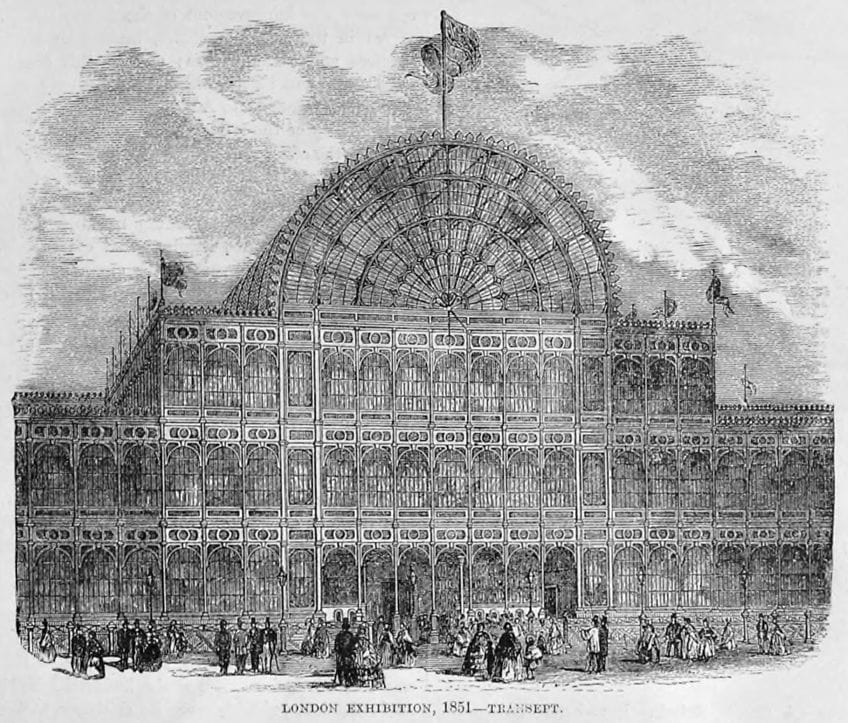
Furthermore, this first exhibition had some extremely famous visitors. People like Charles Darwin, Lewis Carroll, Samuel Colt, George Eliot, Charlotte Brontë, Michael Faraday, and Karl Marx attended this incredibly famous first Great Exhibition. So, the Crystal Palace’s ability to draw in crowds was significant. Once the Crystal Palace Building was forced to relocate, it continued to house various technological marvels. Not quite on the same scale as the Great Exhibition of 1851, but it was no longer the site for an international show and was instead a tourist destination. However, it continued to be a showcase for technology long after its initial purpose was gone.
The Legacy of the Building
The building itself, aside from it housing the Great Exhibition, was influential. In subsequent World’s Fairs, glass structures became common, and so did temporary buildings and pavilions. So, in terms of the Great Exhibitions to follow, the Crystal Palace Building in London had an impact, but its real impact was architectural.
In subsequent decades, the Crystal Palace Building would go on to influence Modern architecture.
The use of a metallic framework and a glass façade became a common element in Modernist design, especially in skyscrapers. In addition, the modular nature of the Crystal Palace was revolutionary in showing what could be done with structures in the future. The Crystal Palace would go on to have a profound influence on architecture going forward.
Restoration Efforts of the Crystal Palace Building
Over the years, there have been various attempts and proposals to rebuild the Crystal Palace Building in London, but none of these have ever gained much footing. The closest any of these came was very recent, but that too actually fell through relatively soon after it had even been announced.

The Campaign to Save the Crystal Palace
There were those who wanted to see a new Crystal Palace Building in London being recreated, but there has always been local pushback to the idea. The Crystal Palace represented something. It was a representation of the Victorian era and a wish for a utopian future that promised technological marvels. However, it was also something that is often seen as part of the past.
There have, despite this, been moves towards recreating and rebuilding the Crystal Palace.
The biggest campaign with regard to the Crystal Palace is actually in favor of the present existence of the site as a park. When plans to rebuild the structure came to fruition, locals wanted to instead keep the current version of the site. Practically no local support exists for a complete recreation of the old building.
Plans for the Restoration of the Building
The biggest and most likely plans to recreate the Crystal Palace Building in London came in recent years. In 2013, a Chinese company, the ZhongRong Group, tried to build a new attraction on the site that once housed the Crystal Palace Building, but those plans never quite came together even though the company made big promises about the kind of economic benefits that could come with restoring this famous building.

Challenges and Obstacles
The plans to restore the building received immense pushback. Local residents did not want a new Crystal Palace being reconstructed in their neighborhood. There were calls from various local groups, the British Green Party, and even the Labor Party to refrain from any new construction decisions. This, along with the expiration of certain plans, ultimately led to the entire reconstruction effort being scrapped in 2015.
The Crystal Palace Park is currently all that remains of this old building.
The Crystal Palace Building Today
The Crystal Palace in London no longer exists in the state that it did. The building was once an actual structure that was standing for all to see and visit. It was a representation of a possible utopian future for so many people. However, it did not survive into the present day and was instead destroyed, but this does not mean that the site of the Crystal Palace no longer exists.

Current State and Condition of the Building
All that remains of the original Crystal Palace in London are the terraces, staircase, and statues that once formed part of the Crystal Palace and its displays. There was once a water tower beside it, but it was removed during the Second World War. It’s commonly believed that this was to stop it from being used as a landmark by the Luftwaffe during the war. One of the most interesting remaining aspects of the Crystal Palace is the dinosaurs. These sculptures were created from 1852 to 1855, and they depict what people thought dinosaurs looked like.
They are very wrong in their presentation, but they are still fascinating artifacts of a bygone age.
The Proposed Uses of the Building
There have been plans to redesign the old Crystal Palace Building in London, but these plans have ultimately fallen through at the time of writing. So, at the moment, Crystal Palace Park continues to be open to the public for all who wish to visit the site that had once been home to one of the most famous pieces of pre-Modern architecture. After what happened to the Crystal Palace, and the spectacle of the whole affair, it may be best to leave it as it is.

The Impact of the Crystal Palace on the Surrounding Area
The Crystal Palace Building in London had an influence on the area where it was placed because wherever the building went, crowds also went. So, there were those when the building was relocated who were not happy with what was essentially a tourist trap being placed right next to their home. The building did also bring business and attention to the locations in which it was placed though. However, when plans to rebuild the Crystal Palace were underway, there were many local residents who were against the idea. If your small and quiet region may suddenly get a massive tourist destination, you too may be against such an idea.
So, the impact of the Crystal Palace on the surrounding area is a bit of a mixed bag.
The Crystal Palace Building and Its Influence on Popular Culture
The Crystal Palace in London would become an important structure in the history of world architecture because of what it came to represent. It did indeed have an influence on architecture, but it also had an influence on popular culture.

The Use of the Building in Films and Television
The Crystal Palace in London has been used in a variety of films and TV shows. One of the most notable to have used the actual Crystal Palace was Alfred Hitchcock’s The Pleasure Garden from 1925, but there have been numerous other instances of the Crystal Palace being recreated and used as a set. Some of these include things like The Italian Job, some episodes of Doctor Who, and even the recent Netflix drama The Crown.
The Crystal Palace is an iconic London landmark, and even though it no longer exists to this day, it has remained one of the most stunning sights in the city.
The Role of the Crystal Palace in Literature and the Arts
Other than film, the Crystal Palace in London has also been featured in arts and literature, such as being used in the world of Nikolay Chernyshevsky to represent a future utopianism. It was also referenced in several of the works of Fyodor Dostoevsky. The Crystal Palace was a location that ignited the imaginations of many who saw it, so it makes sense that the building has been recreated or mentioned in many pieces of popular culture.
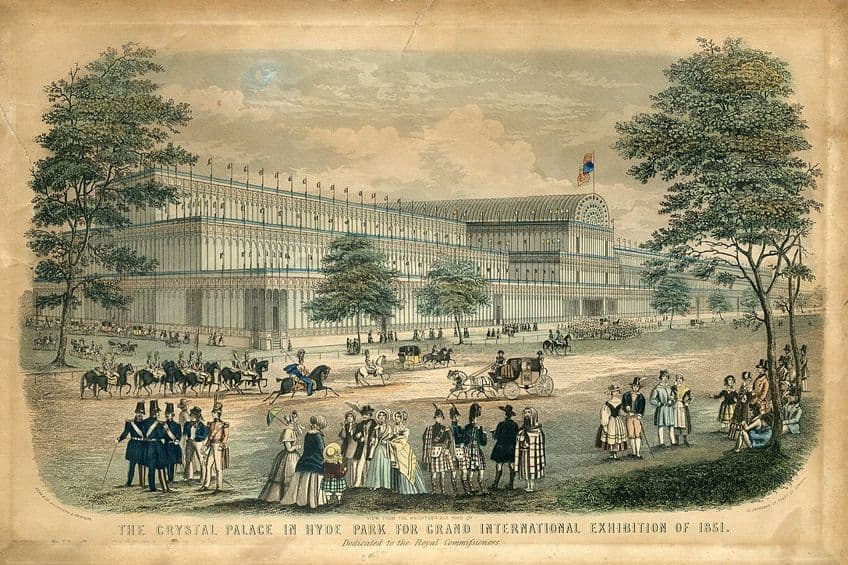
We have come to the end of our discussion about the Crystal Palace in London. This now-destroyed building was once one of the most influential pieces of architecture in the world. It represented something new and different; something wholly unique and futuristic. In this article, we examined the Crystal Palace’s history, construction, influence, present-day existence, and its place in popular culture. Hopefully, you have learned a good deal about this important piece of pre-Modern architecture, and now you can go and read about what it all influenced!
Frequently Asked Questions
What Was the Great Exhibition, and Why Was It Significant?
The Great Exhibition of 1851 was a World’s Fair that saw inventors from around the world gather together in one place to show off the kind of technology that they had invented. The idea behind it was to foster a sense of international collaboration, and as many World’s Fairs followed in its wake, the first of these Great Exhibitions was indeed a significant thing.
Who Designed the Crystal Palace, and How Was It Constructed?
The Crystal Palace in London was designed by Joseph Paxton. He was a garden designer and had significant experience in designing greenhouses. He used his experience with building these glass-based greenhouses to design a modular construction that would be relatively inexpensive, while also being sturdy and striking in its visual presentation.
Why Was the Crystal Palace Relocated to Sydenham Hill?
The Crystal Palace was ultimately relocated because the Great Exhibition had come to an end and the Hyde Park location had been a leased property. This meant that those in charge had to either choose to demolish the popular structure or move it to a new location. The decision was ultimately made to move it to a more affluent location for its permanent home.
When Was the Crystal Palace Destroyed, and What Caused It?
The Crystal Palace in London survived for several decades until a small fire broke out inside. That small fire had a lot of old wooden floors that it could use as kindling, and glass tends to fare poorly against fire. Within a few hours, the Crystal Palace was gone. The fire started and consumed everything on the evening of 30 November 1936.
What Is the Current State of the Crystal Palace, and Is It Open to the Public?
The Crystal Palace itself is gone, but the location that had once housed it is now home to Crystal Palace Park. This part is open to the public and contains several attractions, such as a museum, some of the sculptures that survived the fire, and a maze. There are plans to expand the current attractions in the park.
How Has the Crystal Palace Influenced Architecture and Design?
The Crystal Palace in London was immensely important for architectural design because it showed how iron frameworks and glass could be used in construction, while also showing how modular designs could be adopted. Furthermore, it would have a profound influence on Modern architecture.
Justin van Huyssteen is a writer, academic, and educator from Cape Town, South Africa. He holds a master’s degree in Theory of Literature. His primary focus in this field is the analysis of artistic objects through a number of theoretical lenses. His predominant theoretical areas of interest include narratology and critical theory in general, with a particular focus on animal studies. Other than academia, he is a novelist, game reviewer, and freelance writer. Justin’s preferred architectural movements include the more modern and postmodern types of architecture, such as Bauhaus, Art Nouveau, Art Deco, Brutalist, and Futurist varieties like sustainable architecture. Justin is working for artfilemagazine as an author and content writer since 2022. He is responsible for all blog posts about architecture.
Learn more about Justin van Huyssteen and about us.
Cite this Article
Justin, van Huyssteen, “Crystal Palace Building in London – Explore the Historic Site.” artfilemagazine – Your Online Art Source. August 17, 2023. URL: https://artfilemagazine.com/crystal-palace-building-in-london/
van Huyssteen, J. (2023, 17 August). Crystal Palace Building in London – Explore the Historic Site. artfilemagazine – Your Online Art Source. https://artfilemagazine.com/crystal-palace-building-in-london/
van Huyssteen, Justin. “Crystal Palace Building in London – Explore the Historic Site.” artfilemagazine – Your Online Art Source, August 17, 2023. https://artfilemagazine.com/crystal-palace-building-in-london/.


